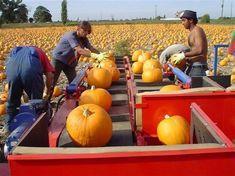
Martin Tate, commercial director with LFP, said the original concept was a ‘fag packet’ design which was taken to a local engineering firm.
He said: “We’d seen our pumpkin business grow within Asda considerably over the last few years. It’s one thing to manually handle 100,000 pumpkins, but now we’re dealing with more than one million.”
The company spent around £70,000 on the initial harvester for last season, but Tate estimated it has spent a further £30,000 modifying the machine for this year.
The equipment allows the pumpkins to be placed on a conveyor belt at right angles to the harvester. The vegetables are then taken into a tank to be sprayed with pressurised jets to clean off excess mud.
Another belt then carries the pumpkins through the back of the machine and into crates, which are then lifted off and taken for storage.
Tate said: “We used it last year, but we’ve done some modifications this year to get it as close to the ideal machine for the job.” He said the machine will allow them to harvest around 10 acres a day, equating to around 50,000 pumpkins, and they expected to have harvested around one million pumpkins in 20 days.
“The machine lets us harvest in any weather, so we won’t be held up by rain and can get out in the fields every day.“It also means less handling, as basically the pumpkins are handled once as they’re put on the machine.” The washing facility also saves time and effort.
Overall he said it has had three major impacts on their business: “It allows us to save money, improve the quality of the pumpkins by less handling, and guarantee availability by being out in the fields whatever the weather.”
TONG PUTS SAFETY FIRST
It is safety first with the latest launch from produce packaging machinery experts Tong Engineering.
The company’s latest offering - the Jet-Fill -- a big bag filler, has a new safety feature built in, which also help to make the machine easier for the operators to use.
The machine features a down position for the filling mechanism which enables the operator to fit empty bags at an easy-to-reach height, instead of having to use a step.
Pressing the start button raises the bag to filling position, with the bag platform also rising. The delivery layer can then feed the crop into the bag with the minimum dropping distance. As the bag fills, a sensor on the conveyor automatically lowers the bag platform.
When the bag is full, the conveyor belt either stops or reverses, if there is a bag fitted to the other side. In the meantime, the bag platform continues to lower so the full bag is suspended from the hooks to settle the contents before rising once more to close the hooks and allow a fork lift to remove the filled bag.
Barry Ledger, sales manager with Tong Engineering, said: “The introduction of a lower height for attaching the bags will be welcomed by operators, and make the job more efficient as well as safer.
“Emphasis has been put on operator safety without distracting from the performance of the machine. It is evident from our visits to mainland Europe where we have seen big bag fillers in operation that there is a definite requirement for a machine which has correct ‘safe working’ features. We have secured recent orders for the Jet-Fill from France, Spain and Egypt.”
The machine has a capacity of up to 20 tonnes an hour.
GAINS MADE FROM MODULAR APPROACH
Gainsborough Engineering has found that its modular range of VFFS machines is just what the dynamic fresh produce market is looking for, as over a third of their VFFS machine production has gone into fresh produce applications in the last 12 months.
The applications range from small high-speed packs of 80g of sliced apples to 10kg of peeled potatoes in a modified atmosphere.
Wayne Kedward, UK sales manager, said: “We believe our success has been due to customers in this market looking for a UK manufacturer of VFFS machines which are cost effective, reliable and versatile.”
Kedward said some of the advantages of the GV2K produce machines include one of the lowest product drop heights on the market, gentle product handling and delivery systems along with the ease of integration with existing weighing equipment.
The GV2K3P Bagger has made up the majority of sales in this area due to the wide range of produce it can handle and bag size range it offers. The standard format machine is being used for onions, potatoes and whole carrots, where as the high care IP65 machine is being used for prepared vegetables and fruit such as “lunch box” baton carrots and sliced apples, along with mixed vegetable packs, salads other ready to eat vegetables, and fruits.
The “lunch box” sliced apples pack contains an equal amount of both red and green apple slices, which is being marketed as a healthier convenience snack for school lunch boxes by a leading supermarket.
The main specification from the customer was to pack at speed but avoid any damage to the apple slices as they bruise easily.
This was overcome by keeping the product drop-heights to an absolute minimum, achieved using a combination of specially designed feeders to spread out the slices before feeding onto separate shallow angled elevators. A unique wiping mechanism at the top of each elevator ensures that all the slices are transported to the weigher with minimum contact.
The slices are fed into a split weigher, which drops equal amounts of each colour of sliced apple into the bag, and gas flushed to increase the shelf life. Product changeovers are quick due to the system being able to be completely washed down, having quick release forming tubes and machine settings changed automatically via the touch screen.



